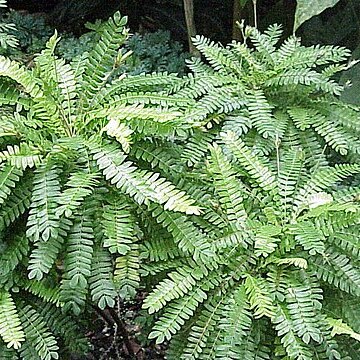Herbs or subshrubs, erect or decumbent, the base sometimes ligneous; stems generally bearing a ring of rigid, retrorse pubescene at the apex. Leaves fascic-ulate at the stem apex, imparipinnate, the terminal leaflet reduced to a bristle-like mucro; leaflets subsessile, the pairs gradually modified in shape and size upwards, the lower pairs usually subtriangular or ovate, smaller, petiolule minute, broader than long, fleshy; petiole short, thick, articulating at the rachis, the bases persistent on the stem. Inflorescences of cymes, globose or cylindric; peduncu-late; bracts subulate, situated at the insertion of the peduncles; bracteoles spirally overlapping; pedicels shorter or longer than the bracteoles, articulate near the base, the flowers opening successively, often only 1 or 2 to several seen opened to different degrees. Flowers white to red; sepals almost free, imbricate; petals connate near the middle; stamens short-connate at the base, all fertile or some-times the shorter stamens reduced and sterile; ovary 5-lobed, the carpels 2-6-ovulate, the ovules in two rows alternating in length, the stigmas terminal, en-larged, bifid, subcapitate, papillose. Fruit a capsule covered by the calyx, the carpels 1-6-seeded, loculicidally dehiscent, the valves opening flat over the sepals in a star shape, remaining attached at the base; seeds 2-tegmic, the outer tegument opening and ejaculating the seed at maturity.
Annual or perennial herbs, with a simple or branched stem, or stem very short and then plants with a thick woody rootstock. Leaves fascicled or almost whorled at the top of the stem or branches, paripinnate (the rhachis ending in a bristle), exhibiting a certain degree of sensitivity to touch; petiole swollen and articulated near the base; leaflets many, opposite or subopposite, subsessile or shortly petiolulate, obliquely rectangular or orbicular, unequal-sided. Flowers in pseudumbels, white, pink, yellow or orange; bracts small, persistent, forming an involucre at the base of the pedicels. Sepals strongly parallel-veined, the inner ones in relation to the pseudumbel narrower than the outer. Petals contorted in bud, becoming shortly adherent above the free base, falling off together in a bunch. Stamens 10, 5 outer short and 5 inner long; filaments shortly connate or almost free at the base. Ovary 5-lobed; styles notched or 2-fid at apex. Capsule ovoid or oblong, dehiscing loculicidally, the valves finally spreading. Seeds tuberculate, rugose or ribbed.
Erect annual herbs or usually sympodially branched dwarf shrubs. Leaves paripinnate in tufts at the end of the stem or branches, with setaceous stipules; leaflets opposite, subsessile, terminal pair mostly different from the others, their acroscopical half of base cuneate, basiscopical half rounded to truncate, rachis prolonged in a mucro. Flowers terminal in a usually peduncled, bracteate pseudo-umbel, heterodi-, tri-or homostylous. Pedicels articulate at base. Sepals glabrous inside, ± free. Petals contort, glabrous, coherent above the claw. Filaments: shorter ones with a more or less pronounced callus at base, longer ones always edentate. Styles in LF and MF ciliate; stigmas terminal, subulate and entire or spoon-shaped to flattened, crenate to bifid; ovules 3-6 per cell, alternating in 2 rows. Capsule finally loculicid to the base, forming a 5-rayed star. Seeds 1-6 per cell, aril white, thin, at maturity bivalved and ejaculatory.
Herbs, annual or perennial. Stem sometimes woody at base, simple or dichotomously branched. Stipules filiform. Leaves crowded or almost whorled apically on stems, even-pinnate; petiole basally swollen; leaflets opposite, sessile; leaflet blade apices rounded and mucronate; apical leaflet blade reduced to an awn. Inflorescences umbellate, pedunculate or sessile. Sepals lanceolate, persistent in fruit, apex acuminate. Petals yellow, white, or rarely purple. Ovary subglobose. Capsule ovoid to oblong, loculicidally dehiscent, sometimes splitting to base into 5 spreading valves, each valve with several seeds. Seeds brown, often with small tubercles.
Leaves usually in rosettes at the apex of the stem or at ground-level on the rootstock, paripinnate (the abortive terminal leaflet represented by a bristle), ± sensitive, usually articulated just above the insertion; leaflets opposite or subopposite, very shortly petiolulate or subsessile.
Petals 5, contorted, free at first but eventually coherent and falling off together in a mass.
Flowers orange, yellow, white or pinkish, in pseudumbels with bracts forming an involucre.
Caulescent or acaulescent annual herbs or perennial herbs with woody rootstock.
Stamens 10, 5 longer and 5 shorter, all slightly connate at the base.
Capsule obovoid, subglobose, or ellipsoid, loculicidally dehiscent.
Seeds usually tuberculate.
Sepals 5, free, imbricate.
Ovary 5-locular, 5-lobed.

